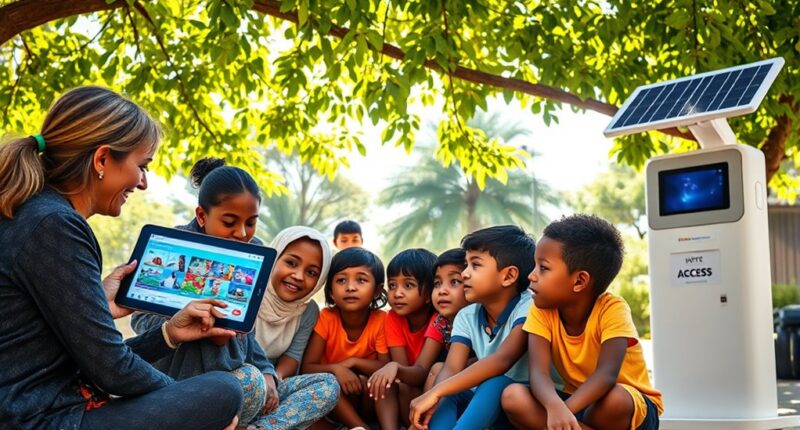To promote equitable education, you need to address the digital divide by ensuring reliable internet access and providing devices to all students. Bridging this gap involves investing in infrastructure, offering digital literacy training, and supporting community programs. When everyone can connect and use technology confidently, educational opportunities become fairer and more inclusive. If you’re interested in ways to make a difference, explore how these strategies shape a more equal future in education.
Key Takeaways
- Expanding internet infrastructure ensures reliable access for underserved communities, promoting equitable educational opportunities.
- Providing devices and digital literacy training helps students and educators utilize technology effectively.
- Community programs and workshops bridge skills gaps, empowering learners across all age groups.
- Policy advocacy and investment are essential to address both hardware access and digital literacy development.
- Closing the digital divide fosters inclusive learning environments and promotes social and educational equity.

Have you ever wondered why some communities still struggle to access reliable internet while others thrive? The answer often lies in disparities around technology access and digital literacy. When technology isn’t readily available, students and community members find it hard to keep up with educational demands that increasingly depend on digital tools. If you’re in a community where high-speed internet is a given, it may be hard to imagine the barriers faced elsewhere. But for many, limited infrastructure means unreliable connections, long download times, or no internet at all. Without consistent access, students miss out on online classes, research opportunities, and digital resources that are now fundamental to learning. Bridging this gap requires addressing the root issues of technology access, guaranteeing that everyone has the devices and internet connections necessary to participate fully in education.
Disparities in internet access and digital literacy hinder equitable education for many communities.
However, providing access alone isn’t enough. Digital literacy plays a vital role in closing the gap. Even if students have devices and internet, they need to know how to navigate digital platforms effectively. Without digital literacy skills, students might struggle with online assignments, security, or understanding how to evaluate credible sources. You might have access to all the necessary tools, but if you don’t know how to use them, your ability to learn and succeed diminishes. Schools and community organizations must prioritize digital literacy education, teaching not just how to operate devices but also how to think critically about online content and protect personal information. Developing digital literacy skills empowers learners to utilize technology confidently and safely in their academic and everyday lives.
Efforts to bridge the digital divide must be holistic. Governments and local agencies can invest in infrastructure projects to expand internet access to underserved areas. Schools can provide devices and dedicated training to ensure students are comfortable using digital tools. Community programs can host workshops that teach digital skills, helping learners of all ages become confident digital citizens. As someone invested in equitable education, you can advocate for policies that prioritize both technology access and digital literacy initiatives. Recognize that closing this gap isn’t just about hardware or connectivity; it’s about empowering individuals with the skills they need to navigate the digital world confidently.
Ultimately, addressing technology access and digital literacy isn’t just a matter of convenience; it’s a necessity for equitable education. When everyone has the tools and skills to participate fully, you foster an environment where learning is accessible and inclusive. Bridging the digital divide means creating opportunities for all, ensuring that no student is left behind simply because they lack the resources or knowledge to thrive in today’s digital age.
Frequently Asked Questions
How Can Community Organizations Support Digital Equity Initiatives?
You can support digital equity initiatives by offering technology training that empowers community members to use digital tools confidently. Additionally, you should focus on resource distribution, ensuring devices and internet access reach underserved populations. By partnering with local schools and organizations, you create a stronger support system, making technology accessible and fostering digital literacy. Your efforts help bridge the digital divide, promoting equal opportunities for all community members.
What Role Do Policymakers Play in Closing the Digital Divide?
Policymakers play a vital role in closing the digital divide by implementing policies that promote digital access and literacy. You can explore how effective policy implementation guarantees equitable resource distribution, while innovative funding strategies, like grants and public-private partnerships, provide necessary financial support. By actively shaping these initiatives, policymakers help create an inclusive digital environment where everyone has the tools they need for success.
How Can Parents Assist Children With Limited Internet Access?
You can assist children with limited internet access by creating opportunities for offline learning. Use resources like printed materials, workbooks, and educational games to keep them engaged. Encourage setting up devices with offline capabilities and downloading lessons when possible. Additionally, talk with your child’s teachers about alternative ways to access assignments and support their learning without relying solely on home internet, ensuring they stay connected and engaged.
What Are Effective Methods to Measure Digital Literacy Progress?
You can measure digital literacy progress effectively by using assessment tools that evaluate specific skills and knowledge. Set clear skill benchmarks to track improvements over time, and regularly administer these assessments to identify areas needing reinforcement. Observing how your child navigates online tasks and solves digital problems also offers valuable insights. Combining formal assessments with practical observations ensures an extensive understanding of their digital literacy development.
How Does the Digital Divide Impact Long-Term Educational Outcomes?
You’re impacted by technological disparities and socioeconomic barriers that widen the digital divide, ultimately affecting your long-term educational outcomes. Limited access to devices and reliable internet hampers your ability to participate fully in online learning, slowing your academic progress and future opportunities. These barriers create unequal learning environments, making it harder for you to develop essential skills, succeed in higher education, and secure well-paying jobs, perpetuating cycles of inequality.
Conclusion
By working together to bridge the digital divide, you can create a future where everyone has equal access to educational opportunities. Imagine a world where technology empowers every student, regardless of their background. Are we willing to let inequality hold back potential, or will you take action to guarantee a fairer, more inclusive education for all? The choice is yours—let’s make digital equity a reality and open endless possibilities for every learner.










